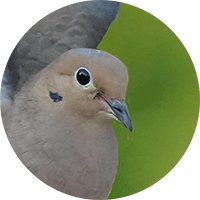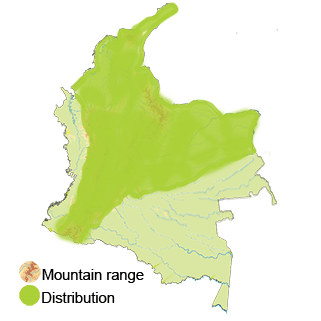Mourning Dove
The Mourning Dove (Zenaida macroura) in Colombia: Read in Spanish
Appearance: The Mourning Dove is a medium-sized, slender dove with a gray-brown body, a pointed tail with white edges, and a distinctive black spot on the lower side of its cheek. They have long, pointed wings and display iridescent hues on their necks during certain light conditions. Mourning Doves are known for their gentle appearance and graceful flight.
Habitat: The Mourning Doves inhabit a variety of open habitats, including farmlands, grasslands, scrublands, urban areas, and forest edges. They are commonly found in areas with access to water sources and open spaces for foraging.
Behavior: Mourning Doves are known for their soft, melodic cooing calls and their fluttering, fast flight. They are primarily ground foragers, feeding on seeds, grains, and small insects. Mourning Doves form pairs during the breeding season and are often seen perched on wires or branches.
Breeding: Mourning Doves typically breed in the spring and summer months. They build flimsy nests made of twigs and grasses in trees, shrubs, or ledges. The female lays two white eggs, and both parents take turns incubating them. The young are cared for by both parents and fledge within two weeks.
Conservation Status: The Mourning Dove is not considered a threatened species.
Distribution
The Mourning Dove (Zenaida macroura)
Andean Region: The Andean region of Colombia, which includes the Andean mountain range and surrounding areas, provides suitable habitat for Mourning Doves. They can be found in areas with agricultural lands, forest edges, and urbanized areas throughout the Andean region.
Caribbean Region: Mourning Doves are also present in the coastal and inland areas of the Caribbean region of Colombia. They can be found in diverse habitats such as farmlands, scrublands, and urban areas in this region.
Orinoco Region: In the Orinoco region, which includes savannas, wetlands, and forests, Mourning Doves can be observed in areas with open spaces for foraging and perching. They may also utilize agricultural lands and rural areas within the Orinoco region.
Amazon Region: The Amazon region of Colombia, with its vast rainforests and river systems, provides a unique habitat for Mourning Doves. They can be found in forest clearings, riverbanks, and disturbed areas within the Amazon region.
Pacific Region: Along the Pacific coast of Colombia, Mourning Doves can be found in coastal areas, agricultural lands, and urban environments. They may also occur in forest edges and open spaces near human settlements in the Pacific region.
Taxonomy
The Mourning Dove (Zenaida macroura)
- Kingdom: Animalia
- Phylum: Chordata
- Class: Aves (Birds)
- Order: Columbiformes
- Family: Columbidae
- Genus: Zenaida
- Species: Zenaida macroura
Vocalization
The Mourning Dove (Zenaida macroura)
- Coos: The most recognizable vocalization of the Mourning Dove is its soft, mournful "coo" call. This sound is often described as a series of cooing notes that sound like "coo-ah, coo, coo, coo." The cooing call is used by males to attract mates and establish territories.
- Wings Whistling: Mourning Doves are also known for the sound of their wings whistling during flight. When taking off or landing, their wings produce a distinctive whirring or whistling sound caused by the air passing through their wing feathers. This sound is characteristic of Mourning Doves in flight.
- Chirps and Calls: In addition to their cooing vocalizations, Mourning Doves produce a variety of other sounds, including soft chirps, fluttering sounds, and occasional alarm calls. These vocalizations can serve as communication signals between doves in a flock or pair.
- Nesting and Courtship Calls: During nesting and courtship periods, Mourning Doves may exhibit specific vocalizations, including soft coos exchanged between mating pairs and calls associated with nest-building activities. These calls help establish and strengthen pair bonds during the breeding season.
- Alarm Calls: When threatened or disturbed, Mourning Doves may emit alarm calls that alert other doves to potential dangers. These alarm calls are typically short, sharp sounds that signal a need for vigilance or evasive action.





